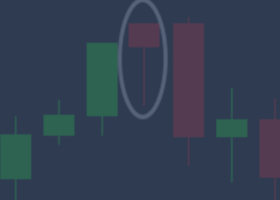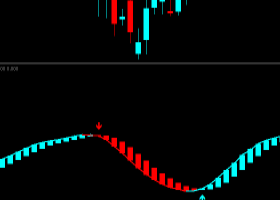Essential Design
The market's compound construction is such that two waves of a particular degree subdivide into eight waves of the next lower degree, and those eight waves subdivide in exactly the same manner into thirty-four waves of the next lower degree. The Wave Principle, then, reflects the fact that waves of any degree in any series always subdivide and re-subdivide into waves of lesser degree and simultaneously are components of waves of higher degree. Thus, we can use Figure 1-3 to illustrate two waves, eight waves or thirty-four waves, depending upon the degree to which we are referring.
Now observe that within the corrective pattern illustrated as wave [2] in Figure 1-3, waves (A) and (C), which point downward, are each composed of five waves: 1, 2, 3, 4 and 5. Similarly, wave (B), which points upward, is composed of three waves: A, Band C. This construction discloses a crucial point: Motive waves do not always point upward, and corrective waves do not always point downward. The mode of a wave is determined not by its absolute direction but primarily by its relative direction. Aside from five specific exceptions, which will be discussed later in this course, waves divide in motive mode (five waves) when trending in the same direction as the wave of one larger degree of which it is a part, and in corrective mode (three waves or a variation) when trending in the opposite direction. Waves (A) and (C) are motive, trending in the same direction as wave [2]. Wave (B) is corrective because it corrects wave (A) and iscountertrend to wave [2]. In summary, the essential underlying tendency of the Wave Principle is that action in the same direction as the one larger trend develops in five waves, while reaction against the one larger trend develops in three waves, at all degrees of trend.
*Note: For this course, all Primary degree numbers and letters normally denoted by circles are shown with brackets.
Essential Concepts
Figure 1-4
The phenomena of form, degree and relative direction are carried one step further in Figure 1-4. This illustration reflects the general principle that in any market cycle, waves will subdivide as shown in the following table (see section 1.6).
Wave Numbers
Number of Waves at Each Degree
Impulse + Correction = Cycle
Largest waves 1+1=2
Largest subdivisions 5+3=8
Next subdivisions 21+13=34
Next subdivisions 89+55=144
Number of Waves at Each Degree
| Motive + | Corrective | = Cycle | |
| (Impulse) | (Zigzag) | ||
| Largest waves | 1 | 1 | 2 |
| Largest subdivisions | 5 | 3 | 8 |
| Next subdivisions | 21 | 13 | 34 |
| Next subdivisions | 89 | 55 | 144 |
As with Figures 1-2 and 1-3 in Lesson 2, neither does Figure 1-4 imply finality. As before, the termination of yet another eight wave movement (five up and three down) completes a cycle that automatically becomes two subdivisions of the wave of next higher degree. As long as progress continues, the process of building to greater degrees continues. The reverse process of subdividing into lesser degrees apparently continues indefinitely as well. As far as we can determine, then, all waves both have and are component waves.
Elliott himself never speculated on why the market's essential form was five waves to progress and three waves to regress. He simply noted that that was what was happening. Does the essential form have to be five waves and three waves? Think about it and you will realize that this is the minimum requirement for, and therefore the most efficient method of, achieving both fluctuation and progress in linear movement. One wave does not allow fluctuation. The fewest subdivisions to create fluctuation is three waves. Three waves in both directions does not allow progress. To progress in one direction despite periods of regress, movements in the main trend must be at least five waves, simply to cover more ground than the three waves and still contain fluctuation. While there could be more waves than that, the most efficient form of punctuated progress is 5-3, and nature typically follows the most efficient path.
Variations on the Basic Theme
The Wave Principle would be simple to apply if the basic theme described above were the complete description of market behavior. However, the real world, fortunately or unfortunately, is not so simple. From here through Lesson 15, we will fill out the description of how the market behaves in reality. That's what Elliott set out to describe, and he succeeded in doing so.
WAVE DEGREE
All waves may be categorized by relative size, or degree. Elliott discerned nine degrees of waves, from the smallest wiggle on an hourly chart to the largest wave he could assume existed from the data then available. He chose the names listed below to label these degrees, from largest to smallest:
Grand Supercycle
Supercycle
Cycle
Primary
Intermediate
Minor
Minute
Minuette
Subminuette
It is important to understand that these labels refer to specifically identifiable degrees of waves. For instance, whenwe refer to the U.S. stock market's rise from 1932, we speak of it as a Supercycle with subdivisions as follows:
1932-1937 the first wave of Cycle degree
1937-1942 the second wave of Cycle degree
1942-1966 the third wave of Cycle degree
1966-1974 the fourth wave of Cycle degree
1974-19?? the fifth wave of Cycle degree
Cycle waves subdivide into Primary waves that subdivide into Intermediate waves that in turn subdivide into Minor and sub-Minor waves. By using this nomenclature, the analyst can identify precisely the position of a wave in the overall progression of the market, much as longitude and latitude are used to identify a geographical location. To say, "the Dow Jones Industrial Average is in Minute wave v of Minor wave 1 of Intermediate wave (3) of Primary wave [5] of Cycle wave I of Supercycle wave (V) of the current Grand Supercycle" is to identify a specific point along the progression of market history.
END OF PART 3.



